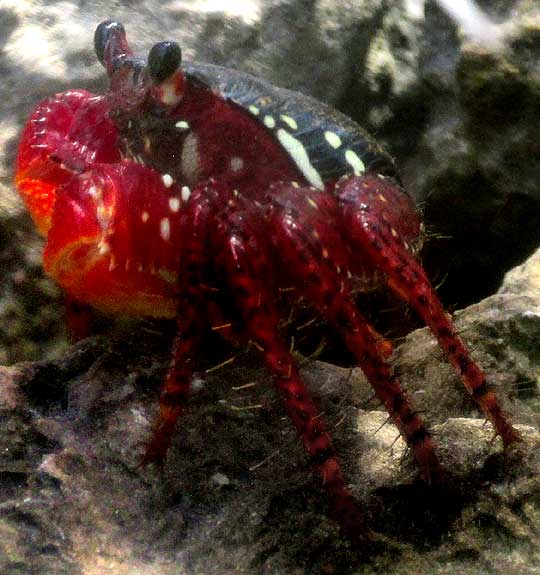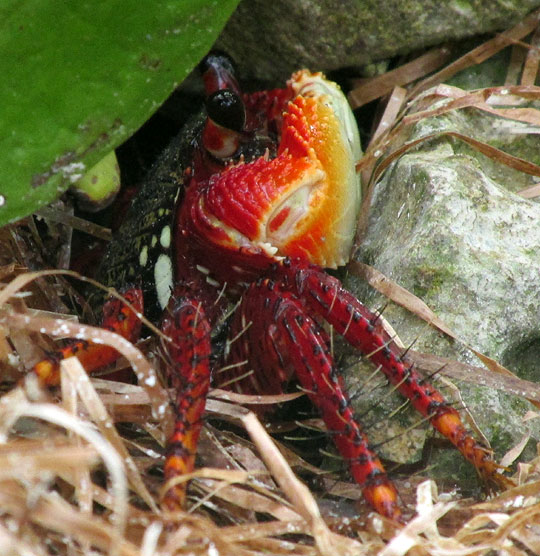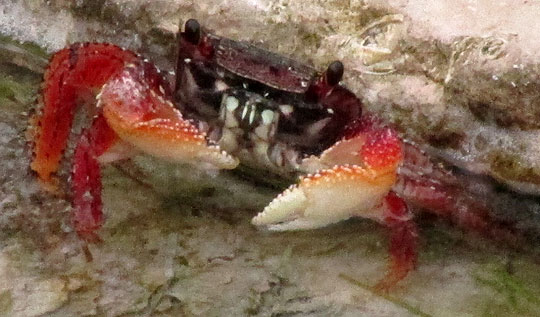Excerpts from Jim Conrad's
Naturalist Newsletter
from the June 7, 2015 Newsletter issued from Río Lagartos, on the Yucatan Peninsula's northern coast (~N21.60°, ~W88.16°), Yucatán state, MÉXICO
MARSH CRABS
In deep shade beneath Black Mangroves, on limestone rocks piled at the road's edge and just above the waterline, something the color of strawberry preserves glowed as if with an inner light. Below, you can see the source:

It was an easy-to-spook land crab, one I'd not seen before, though later my friend Rayo told me he'd spotted them scurrying on mud among tangles of Red Mangrove stilt-roots. As soon as I inched a little closer for a better shot, the crab instantly disappeared and didn't return after a long wait. The next day I returned, though, and got a slightly different view of the skittery fellow, shown below:

This one disappeared and didn't return when I got a little closer, either. On the third day, what I assumed to be the same individual turned up on the same rocks, but the light was worse than ever. However, across the pool of mangrove water, at the water's edge and with a limestone rock at his back, another one was feeding, his pincers conducting such tiny amounts of food to his mouth that I couldn't see anything in them. This is shown below

The black, slender spines on this one's legs appear much shorter or even absent, relative to the others, the black dots on its legs are much less distinct, and the legs themselves are more massive. Could it be a different species? I'm guessing that the differences are a matter of age, and maybe how long it's been since the last molt.
I was so eager to get pictures from different angles because on the Internet I find no pictures matching our crab or crabs. By focusing on anatomical features, however, I did figure out that surely we have a member or members of what's often called the Marsh Crab Family, the Grapsidae. Googling images of each member of the Grapsidae found in the Gulf of Mexico area, I find nothing matching ours.
I did find, however, Lawrence Abele's 1992 work "A Review of the Grapsid Crab Genus Sesarma (Crustacea: Decapoda: Grapsidae) in America, with the Description of a New Genus," in which much confusion within the group is spoken of. It's suspected that various un-named species lurk undetected among many variations sometimes assigned to a single name.
Abele's Armases angustipes is similarly structured to ours, but colored differently. A collection of that species has been made "On unpaved road from Rio Lagartos/San Felipe junction, under rock on margin of nearly dry salina," and that's just a mile or less from where ours live.
So, maybe what we have here is a variation, or variations, of Armases angustipes or, better yet, a taxon still "lurking" -- still un-named -- despite its prettiness and interesting features.
For that future expert who'll figure all this out, I'm glad to deposit our field work here under the Google-indexable keywords SESARMA, ARMASES, Marsh Crab Family, and Grapsidae.